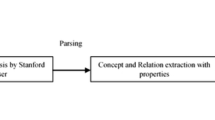Abstract
In the knowledge-based intelligent system, the natural language interface is responsible for implementing communication between end-users and intelligent system using natural language. However the internal information of intelligent system is represented in a certain kind of specific format (knowledge base). When intelligent system need to exchange information with the end-users, it is necessary for natural language interface to obtain the ability to convert fragment of the knowledge base into natural language text. Due to the diversity and complexity of natural language, generating fluent, appropriate natural language text is still a significant challenge. By comparing other methods converting structured data into natural language text, this article describes the characteristics of fragment of knowledge base and the difficulties in natural language generation. The article proposed a unified semantic model to development of natural language generation component of natural language interface. The development of natural language generation component requires a combination of various types of knowledge about linguistics and various problem solving models oriented on natural language generation. In this article the main novelty is that in the unified semantic model the various approaches and linguistic knowledge about natural language generation can be integrated to generate natural language text from the fragment of knowledge base represented in graphical form.
Access this chapter
Tax calculation will be finalised at checkout
Purchases are for personal use only
Similar content being viewed by others
References
Chinese part of ConceptNet. https://conceptnet.io/c/en/chinese. Accessed 04 Oct 2021
DBpedia. https://www.dbpedia.org/. Accessed 04 Oct 2021
Introducing the Knowledge Graph: Things, Not Strings. https://blog.google/products/search/introducing-knowledge-graph-things-not/. Accessed 04 Oct 2021
Zhishi.me. https://zhishi.me/. Accessed 08 Oct 2021
Amit, M., Yoav, G., Ido, D.: Step-by-step: separating planning from realization in neural data-to-text generation. In: Proceedings of the 2019 Conference of the North American Chapter of the Association for Computational Linguistics: Human Language Technologies, Volume 1 (Long and Short Papers), USA, Minneapolis, pp. 2267–2277 (2019)
Androutsopoulos, I., Lampouras, G., Galanis, D.: Generating natural language descriptions from OWL ontologies: the NaturalOWL system. J. Artif. Intell. Res. 48(01), 671–715 (2013)
Banerjee, S., Lavie, A.: METEOR: an automatic metric for MT evaluation with improved correlation with human judgments. In: Proceedings of the ACL Workshop on Intrinsic and Extrinsic Evaluation Measures for Machine Translation and/or Summarization, Ann Arbor, Michigan, pp. 65–72. Association for Computational Linguistics, June 2005
Claire, G., Anastasia, S., Shashi, N., Perez-Beltrachini, L.: The WebNLG challenge: generating text from RDF data. In: Proceedings of the 10th International Conference on Natural Language Generation, Spain Santiago de Compostela, pp. 124–133 (2017)
Davydenko, I.: Semantic models, method and tools of knowledge bases coordinated development based on reusable components. In: 8th International Scientific and Technical Conference “Open Semantic Technologies for Intelligent Systems”, Minsk, Belarus, pp. 99–118 (2018)
Golenkov, V., Gulyakina, N.: Project of open semantic technology of component designing of intelligent systems. Part 1 principles of creation. Ontol. Des. 1(11), 42–64 (2014)
Lin, C.Y.: ROUGE: a package for automatic evaluation of summaries. In: Text Summarization Branches Out, Barcelona, Spain, pp. 74–81. Association for Computational Linguistics, July 2004
Liu, M.J., Wang, M.Y.: Chinese verbs and their categorization: construction and application of the semantic network of Chinese verbs. Lexicographical Stud. 2019(02), 42–60 (2019)
Meteer, M.W.: Bridging the generation gap between text planning and linguistic realization. Comput. Intell. 07(04), 296–304 (1991)
Papineni, K., Roukos, S., Ward, T., Zhu, W.: BLEU: a method for automatic evaluation of machine translation. In: Proceedings of the 40th Annual Meeting on Association for Computational Linguistics (ACL), USA, Philadelphia, Pennsylvania, pp. 311–318 (2002)
Plachouras, V., et al.: Interacting with financial data using natural language. In: SIGIR 2016, Italy, Pisa, pp. 1121–1124 (2016)
Qian, L., Li, W.: Ontological approach for generating natural language texts from knowledge base. In: 11th International Scientific and Technical Conference “Open Semantic Technologies for Intelligent Systems”, Minsk, Belarus, pp. 159–168 (2021)
Qian, L., Sadouski, M., Li, W.: Ontological approach for Chinese language interface design. In: Golenkov, V., Krasnoproshin, V., Golovko, V., Azarov, E. (eds.) OSTIS 2020. CCIS, vol. 1282, pp. 146–160. Springer, Cham (2020). https://doi.org/10.1007/978-3-030-60447-9_9
Reiter, E.: Pipelines and size constraints. Comput. Linguist. 26(02), 251–259 (2000)
Sadouski, M.: Ontological approach to the building of semantic models of user interfaces. In: 12th International Scientific and Technical Conference “Open Semantic Technologies for Intelligent Systems”, Minsk, Belarus, pp. 105–116 (2022)
Shunkevich, D.V.: Ontological approach to the development of hybrid problem solvers for intelligent systems. In: 11th International Scientific and Technical Conference “Open Semantic Technologies for Intelligent Systems”, Minsk, Belarus, pp. 63–74 (2021)
Simon, M., Roberto, C., Alicia, B., Leo, W.: FORGe at SemEval-2017 Task 9: deep sentence generation based on a sequence of graph transducers. In: Proceedings of the 11th International Workshop on Semantic Evaluation (SemEval-2017), Vancouver, Canada, pp. 920–923 (2017)
Sutskever, I., Vinyals, O., Le, Q.V.: Sequence to sequence learning with neural networks. In: NIPS 2014, Montreal, Canada, pp. 3104–3112 (2014)
Wang, S., Bond, F.: Building the Chinese open wordnet (COW): starting from core Synsets. In: Proceedings of the 11th Workshop on Asian Language Resources, Nagoya, Japan, pp. 10–18 (2013)
Xu, B., et al.: CN-DBpedia: a never-ending Chinese knowledge extraction system. In: Benferhat, S., Tabia, K., Ali, M. (eds.) IEA/AIE 2017. LNCS (LNAI), vol. 10351, pp. 428–438. Springer, Cham (2017). https://doi.org/10.1007/978-3-319-60045-1_44
Author information
Authors and Affiliations
Corresponding author
Editor information
Editors and Affiliations
Rights and permissions
Copyright information
© 2022 The Author(s), under exclusive license to Springer Nature Switzerland AG
About this paper
Cite this paper
Qian, L., Li, W. (2022). Ontology-Based Natural Language Texts Generation from Knowledge Base. In: Golenkov, V., Krasnoproshin, V., Golovko, V., Shunkevich, D. (eds) Open Semantic Technologies for Intelligent Systems. OSTIS 2021. Communications in Computer and Information Science, vol 1625. Springer, Cham. https://doi.org/10.1007/978-3-031-15882-7_12
Download citation
DOI: https://doi.org/10.1007/978-3-031-15882-7_12
Published:
Publisher Name: Springer, Cham
Print ISBN: 978-3-031-15881-0
Online ISBN: 978-3-031-15882-7
eBook Packages: Computer ScienceComputer Science (R0)




